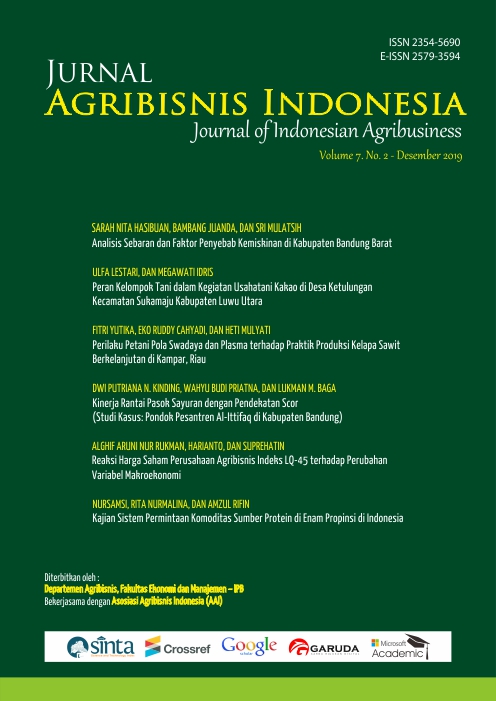ANALISIS SEBARAN DAN FAKTOR PENYEBAB KEMISKINAN DI KABUPATEN BANDUNG BARAT
Main Article Content
Abstract
Poverty is a level of life that below the minimum standard of living needs. The dominant factors that influence the emergence of poverty include education, income, location, limited access to health, finance and public services. Poverty is also one of the crucial issues in West Bandung Regency, where West Bandung Regency has the highest poverty rate compared to surrounding areas such as Bandung City, Bandung Regency, and Cimahi City. The purposes of this study are to analyze the pattern of spatial poverty distribution in general (Moran Index) and in each village (2) Analyze the factors that influence poverty in West Bandung Regency, which are carried out in 165 villages. The results of this study state that there was a positive spatial autocorrelation of 0,464173 which indicated the existence of a link between the poor population in each village and the pattern of poverty that clustered. The LISA test showed the poverty level of the population was clustered into four poverty clusters, namely 17 villages that were in the high-high criteria, 31 villages in the low-low criteria, 5 villages in the low-high criteria and 1 village in the high-low criteria . The factors that influenced poverty in West Bandung Regency were population, education level, village fund allocation, number of groceries, and village funds, while the village index builds, the distance of villages to the capital and the number of people using National electrical corporate (PLN) were not significant to reduce poverty.
Downloads
Article Details
Jurnal Agribisnis Indonesia (JAI) is an Open Access Journal. The authors who publish the manuscript in this journal agree to the following terms:
Creative Commons License
JAI is licensed under a Creative Commons Attribution 4.0 International License. This permits anyone to copy, redistribute, remix, transmit, and adapt the work provided the original work and source are appropriately cited.
This means:
(1) Under the CC-BY license, authors retain ownership of the copyright for their article, but authors grant others permission to use the content of publications in Jurnal Agribisnis Indonesia in whole or in part provided that the original work is properly cited. Users (redistributors) of JAI are required to cite the original source, including the author's name, JAI as the initial source of publication, year of publication, volume number, issue, and Digital Object Identifier (DOI); (2) Authors grant JAI the right of first publication. Although authors remain the copyright owner.
References
Astuti RR. 2015. Analisis Pengaruh Jumlah Penduduk, Pertumbuhan Ekonomi, Pendidikan dan Kesehatan terhadap Jumlah Penduduk Miskin Di Indonesia Tahun 2004–2012. [Skripsi] Yogyakarta (ID): Universitas Negeri Yogyakarta.
Artino, Adi. 2017. Keterkaitan Dana Desa terhadap Kemiskinan di Kabupaten Lombok Utara [Tesis]. Bogor (ID): Institut Pertanian Bogor.
[BPS] Badan Pusat Statistika. 2018. Persentase Penduduk Miskin menurut Perkotaan dan Perdesaan di Indonesia Tahun 2017.
[BPS] Badan Pusat Statistika Provinsi Jawa Barat. 2018. Indeks kedalaman dan Keparahan Kemiskinan Kabupaten Bandung Barat Tahun 2017. Kabupaten Bandung Barat (ID): BPS.
[BPS] Badan Pusat Statistika kabupaten Bandung Barat. 2018. Persentase kemiskinan Kabupaten Bandung Barat Tahun 2014-2019. Kabupaten Bandung Barat (ID): BPS.
Capra T. 2009. Poverty and its Impact on education: Today and Tomorrow. The new Higher Education Journal.
Harmes, Juanda B, Rustiadi E dan Barus B. 2017. Pemetaan Efek Spasial Pada Data Kemiskinan Kota Bengkulu. Journal of Regional and Rural Development Planning, Vol 1 (2):192-201
Hikmat, H. 2004. Strategi Pemberdayaan Massyarakat. Penerbit Humaniora. Bandung.
Irawadi A. 2018. Analisis Kemiskinan Spasial dan Kaitannya dengan Sertifikasi Tanah dan Penggunaan Lahan Pertanian di Kabupaten Mamuju. [tesis.] Bogor (ID): Institut Pertanian Bogor.
Kolopaking LM. 2011. Peningkatan dan Penguatan Struktur Kelembagaan Desa. Menuju Desa 2030. Bogor (ID): Cresrpent Press.
Lee, J., Wong, D.W.S. 2001. Statistical Analysis ArcView GIS. New York: John Wiley & Sons, Inc
Nashwari IP. 2016. Analisis Kemiskinan Petani Tanaman Pangan di Provinsi Jambi dan Jawa Barat menggunakan Geographically Weighted Regression [disertasi]. Bogor (ID): Institut Pertanian Bogor.
Nasution MZ, 2008. Farm Poverty and Rural Poverty in Kulon Progo Regency Indonesia. [internet]. diunduh 27 Oktober 2015. Tersedia dihttps://mpra.ub.uni-muenchen.de/9963/1/MPRA_paper_9963.pdf
Nugraha JT, Sari EDR. 2016. Membangun Indonesia dari Pinggiran melalui Kegiatan Fasilitasi Daerah dalam Penetapan Kawasan Perdesaan Mandiri Pangan untuk Memperkuat Daerah dan Desa di kabupaten Klaten. [internet]. [Diunduh pada tanggal 16 juni 2019]. http://fisipol.untidar.ac.id/wp-content/uploads/2016/10/Fasilitasi-Pemerintah-Daerah-Dalam-Penetapan-Kawasan-Perdesaan-Mandiri-Pangan-Di-Kabupaten-Klaten.pdf.
Prasetyanto PP, dan Eko. 2012 Dampak Alokasi Dana Desa Pada Era Desentralisasi Fiskal Terhadap Perekonomian Daerah Di Indonesia.
[Disertasi]. Bogor (ID) Institut Pertanian Bogor.
Rustiadi E, Saefulhakim S, Panuju DR. 2008. Perencanaan Pengembangan Wilayah . Bogor. Crespent Press $ Yayasan Obor Indonesia.
Sajogyo. 1987. Ekologi Pedesaan, Sebuah Bunga Rampai. Jakarta (ID): Rajawali Pres.
Syafitri UD, Bagus S, Salamatuttanzil. 2008. Pengujian Autokorelasi terhadap Sisaan Model Spatial Logistik. Makalah Seminar Nasional Matematika dan Pendidikan Matematika. Yogyakarka (ID): Universitas Negeri Yogyakarta.

